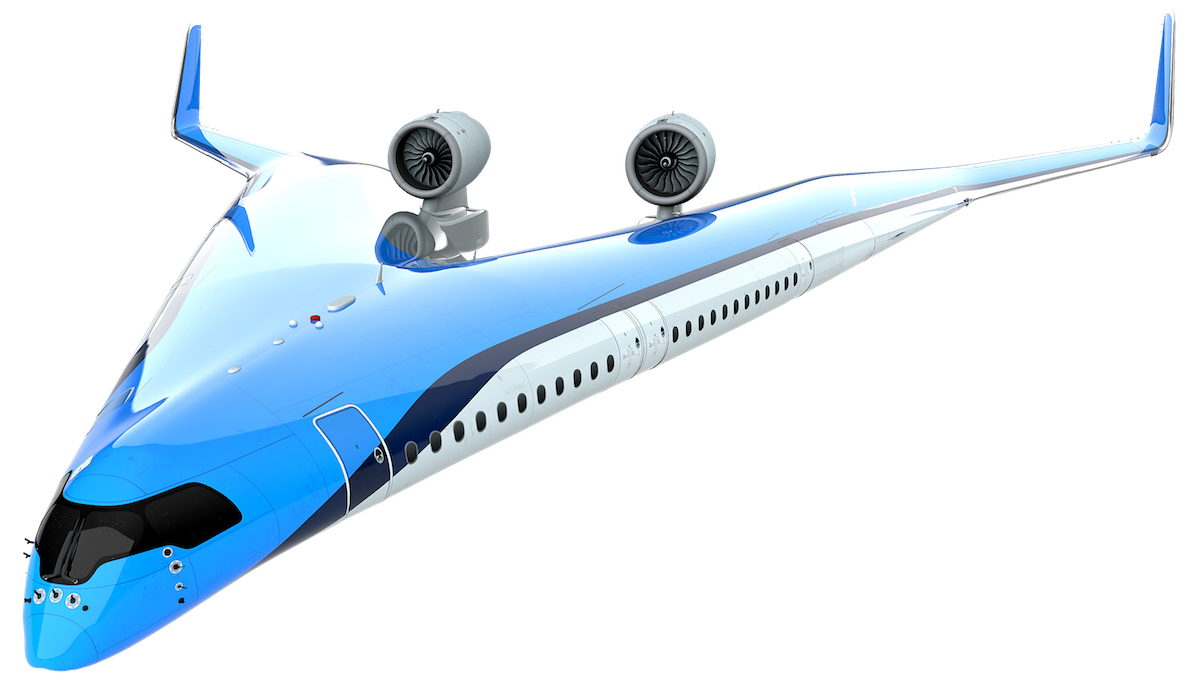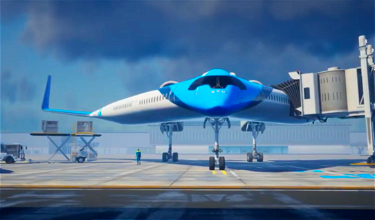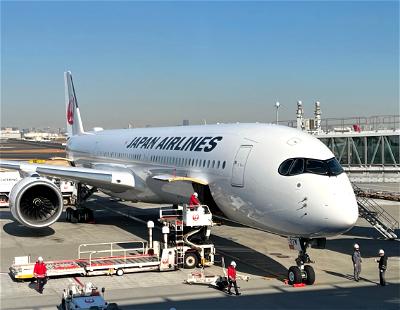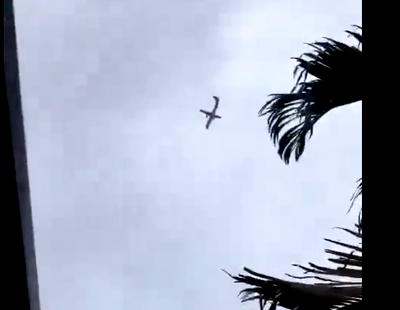Aircraft technology sure has come a long way over the years. Planes are able to fly longer distances more fuel efficiently than ever before, and that’s awesome.
But fundamentally we haven’t actually seen any radical design changes to commercial planes, at least aesthetically. Like, the wings are next to the fuselage, and the engines are typically on the wings (back in the day three engine planes often had an engine on top of the fuselage, but that’s not the case anymore for any major planes in production).
While we’ve seen all kinds of crazy prototypes over the years of what planes could look like in the future, my assumption is typically that they’re made by 11 year old aviation geeks in Paint, without much thought put into the science.
Well, one airline is backing a radically different aircraft design, which I can’t help but share here.
The “Flying V” concept
TU Delft in the Netherlands is working on a “Flying V” concept, and KLM is providing support (including financing) for this project.

The intention is that this radically new aircraft design would be highly energy efficient and be able to operate ultra long haul flights. As you can see, the aircraft’s design integrates the passenger cabin, cargo hold, and fuel tank, into the wings, which is what creates the shape.
The plane could carry 314 passengers, and they say that this design would use 20% less fuel than the Airbus A350, which is otherwise one of the most efficient planes out there.
Here’s a short video about the concept:
The plane would be 55 meters long and have a wingspan of 65 meters. So the wingspan would be the same as the A350, while the plane would be significantly shorter.
Because of this, they say the plane could use the same infrastructure at airports, including gates, runways, and hangars.
A small prototype is expected to fly in October 2019, though that will be just a tiny scale model of what the full plane would look like.
Dr. Roelof Vos, project leader at TU Delft, had the following to say:
“The Flying-V is smaller than the A350 and has less inflow surface area compared to the available amount of volume. The result is less resistance. That means the Flying-V needs less fuel for the same distance.”
Could we ever see this plane flying?
Obviously I’m no aircraft engineer or rocket scientist, so this is just my take. When I first saw this concept, my assumption was that it was a cool idea that could work in theory, but that it’s also a gimmick, and that KLM was behind this project because it makes them look good to be investing in the future.
But the more I look at the details, the more this doesn’t seem that crazy. In particular, the fact that airport infrastructure wouldn’t have to change much is something working in favor of this.
Still, for something so radically different, I can’t even imagine how much money would be going into the design of the plane, and how much funding would be required. While a 20% decrease in fuel burn is good, I’m not sure the savings there are enough to warrant the amount of money that would go into something like this.
The other big issue is that even if the science works out, I wonder if this could actually be certified to fly. In other words, is this type of concept as safe when it comes to emergency evacuations as a traditional plane? My inclination is no, but I of course could be wrong.
What do you think — will we ever see something like the “Flying-V” concept in the skies?





Flying wings have been flown for many decades, since even long before the WW2 era...
SINCE THE 1910's !!!
(Hugo Junkers, 1910 patent!)
We just don't commonly know about them because they were mostly military designs, and associated with secret weapons programs, and part of the earliest "stealth" aircraft programs...smooth, barn swallow shape, plywood laminate with carbon black mixed into the glue to absorb radar....before that was even the word for it.
Flying wings have been flown for many decades, since even long before the WW2 era...
SINCE THE 1910's !!!
(Hugo Junkers, 1910 patent!)
We just don't commonly know about them because they were mostly military designs, and associated with secret weapons programs, and part of the earliest "stealth" aircraft programs...smooth, barn swallow shape, plywood laminate with carbon black mixed into the glue to absorb radar....before that was even the word for it.
The Germans had made deep advances just before the end of the war that the U.S. was fortunate to not really come up against, because the war was over before significant numbers of the German Ho stealth craft .. (jet-powered and basically invisible to radar. zoiks!) could be made combat-ready...and then the U.S. copied and studied the German craft to make an almost identical craft, and that design informs much of the B2 Spirit stealth bomber to this day.
Some flying wings have been vast,
like... almost Spruce Goose vast...
and some are neat little flyers.
https://youtu.be/xSdSnxt_WHs
https://en.m.wikipedia.org/wiki/Northrop_YB-49
https://images.app.goo.gl/3Cvfb9fmLBU1K7k78
I'm not an aero nut by any means, however as per the outter wing passenger seating issue, how about placing the luggage and other non-human materials in the extreme locations on the wings, place the humans in the central area. Put cameras along the outter edges of the plane and screens inside for people to "look outside of the plane". I'm sure they can find a decent perspective that looks close to actually having a...
I'm not an aero nut by any means, however as per the outter wing passenger seating issue, how about placing the luggage and other non-human materials in the extreme locations on the wings, place the humans in the central area. Put cameras along the outter edges of the plane and screens inside for people to "look outside of the plane". I'm sure they can find a decent perspective that looks close to actually having a "window seat" and other perspectives to allow zooming in on the ground or tuning into a movie / netflix / news / youtube / whatever.
Worst case scenario -- outter wing passengers are "lower class" and required to remain seat-belted at all times.
Keep in mind.. they want this plane to go the speed of sound. That makes for shorter flights. It takes 6 hours to cross the US now.
Assuming it gets times similar to the concorde it would take about 3 hours and 55 minutes to cross the US. Also assuming of course that speed of sound is the normal fuel efficient cruise speed.
Interesting design.
Low survivability in a crash compared to cigar fuselage ac. Tons of maint issue especially the high engines like l1011-dc-10. Design aspects could have been squashed by 2 year a&p mech
Me and some of my fellow aero engineering undergraduates looked at almost precisely this sort of concept *30* years ago. ...all the downsides listed above but, since we were *aero* engineers, what put us off was that the low aspect ratio led to poor (subsonic) aero efficiency and difficult control dynamics, especially at lower speeds (the sort that made Concorde 'entertaining' to land). And in the case of this design, the high-mounted engines would make...
Me and some of my fellow aero engineering undergraduates looked at almost precisely this sort of concept *30* years ago. ...all the downsides listed above but, since we were *aero* engineers, what put us off was that the low aspect ratio led to poor (subsonic) aero efficiency and difficult control dynamics, especially at lower speeds (the sort that made Concorde 'entertaining' to land). And in the case of this design, the high-mounted engines would make it more difficult for ground crew to get to the maintenance access panels...with underwing engines, they can get on a ladder or the back of a truck to reach the engines rather than having to get a cherrypicker out on to the apron.
This design has been around for 20+ as said.
Then, it was also muted that the internals would be:
5 aisles, I think it was 22 across! and Tv screens for windows in the centre seats.
Avgeeks better than I will know that this concept is already in production in first or business in the latest revamp of an airline, but I can't remember which one. Maybe SQ.
I also agree, as a former...
This design has been around for 20+ as said.
Then, it was also muted that the internals would be:
5 aisles, I think it was 22 across! and Tv screens for windows in the centre seats.
Avgeeks better than I will know that this concept is already in production in first or business in the latest revamp of an airline, but I can't remember which one. Maybe SQ.
I also agree, as a former FA, that evacuation would be problematic, since the rules state that 90 seconds must be achieved through half the exits, ie one side. I wouldn't like to be seated in the window seat on the banned exit side! Long way across to the exit.
If it had any legs, Boeing, who I believed first muted it, would probably be in production now, or at least flying prototypes in "test", viz the military!
The airline may have to increase cabin crew, because aisles would be diverging into two diagonal directions (vs a single file in current planes). Also, now there would be greater risk in actual passenger space colliding against other craft at airports (vs usually just the wings). If they can mitigate those I think it's worth a shot.
Before seeing a change in fuselage/wing design, you are going to get major changes in the engines first.
Things like gearboxes to have different speeds between the fan and the compressor/turbine cranckshaft (which is a limitation at the moment), or open turbofans such at this one :
https://s3-eu-central-1.amazonaws.com/centaur-wp/theengineer/prod/content/uploads/2016/02/17114601/safransopenrotornigelhoworthawst0.jpg
In the end, since it's the engine that causes fuel burn, changing the engine design first might be more interesting. And this in turn might, such as...
Before seeing a change in fuselage/wing design, you are going to get major changes in the engines first.
Things like gearboxes to have different speeds between the fan and the compressor/turbine cranckshaft (which is a limitation at the moment), or open turbofans such at this one :
https://s3-eu-central-1.amazonaws.com/centaur-wp/theengineer/prod/content/uploads/2016/02/17114601/safransopenrotornigelhoworthawst0.jpg
In the end, since it's the engine that causes fuel burn, changing the engine design first might be more interesting. And this in turn might, such as the case of the open tubofan design, imply an ariplane design change.
Nothing really new there. Here's a similar concept from 2003
https://books.google.ca/books?id=5bKyC4K5tMwC&lpg=PP3&pg=PA44&redir_esc=y#v=twopage&q&f=false
More info:
https://en.m.wikipedia.org/wiki/Blended_wing_body#In_popular_culture
That’s a lot of middle seats.
I think what Boom Supersonic and JAL are developing is more relevant to upcoming aviation trends.
You know the tech is far away when even the digital concept version isn't capable of flight!
Hahaha. It's funny.
Look, guys, KLM is talking about this on A350 scale. Compared to the existing blended wing airplanes (mostly military goodies), A350 is *massive*. Those bombers and fighters are for 1-2 people, and they have effectively unlimited fund to develop and produce (you know America and their armed forces). Trying to say "oh, the concept is possible, let's do a A350 equivalent" is just funny.
Let's imagine for a moment that somehow the...
Hahaha. It's funny.
Look, guys, KLM is talking about this on A350 scale. Compared to the existing blended wing airplanes (mostly military goodies), A350 is *massive*. Those bombers and fighters are for 1-2 people, and they have effectively unlimited fund to develop and produce (you know America and their armed forces). Trying to say "oh, the concept is possible, let's do a A350 equivalent" is just funny.
Let's imagine for a moment that somehow the engineers have solved all theoretical problems (evacuation and motion sickness and whatnot), production alone is going to cost Airbus so much that they will run the other way. Think about it. It would take an entirely different set of production line to produce this thing, and there is about 0 margin of error (imagine if they miscalculate the material fatigue at the nose of this weirdo). And all of their current facilities and current infrastructures will need to be revamped.
I mean, if they want this, they probably need at least a few smaller scale versions first. Maybe a private planes or two. Then, a regional jet of about 30-100 passengers. Then they would finally do a large jet. It takes multiple decades for this to even being conceivably doable. Again, they need anything at B737 or A350 level to be absolutely safe. B737 Max is, compared to your run-of-the-mill car, quite safe (out of many many many thousands segments it has flown, 2 have crashed). And you guys already make a big deal out of its safety. Imagine an untested, probably-have-issues jet design.
I don't even think KLM will survive long enough to see this.
@Evan
It's a British thing.
And not just B-2, similar design for transport was thought since 20s. Search for Junkers J1000.
Flying V is probably just for the Brits.
Almost looks like a paper aeroplane made into a real concept. Its interesting and cool to see how design engineers and scientists create such things. Clever people
designer: Hey, here's a design for the futuristic, fuel-efficient airplane!
engineer: Looks great. How are you going to put it in the air? And how it'll be more efficient than A330?
designer: That's your job to figure out buddy!
engineer: ...
remember when a plane that look similar to this that was rumored at the 797?
Ha!
@Eskimo what are you talking about????!
"This isn’t such a radical design as the flying wing has been in the air for 20+ years
https://en.wikipedia.org/wiki/Northrop_Grumman_B-2_Spirit
The B-2 carries its very small crew up front, on the centerline. Also, for a heavy bomber it actually carries a fairly small payload for its size, certainly when compared to the B-52 or B-1. That's part of the problem with a thick subsonic flying wing - that thick wing and center section isn't the most...
"This isn’t such a radical design as the flying wing has been in the air for 20+ years
https://en.wikipedia.org/wiki/Northrop_Grumman_B-2_Spirit
The B-2 carries its very small crew up front, on the centerline. Also, for a heavy bomber it actually carries a fairly small payload for its size, certainly when compared to the B-52 or B-1. That's part of the problem with a thick subsonic flying wing - that thick wing and center section isn't the most efficient at carrying very heavy loads. To move that somewhat thicker shape with a thick frontal area (hence, more drag) through the air, a lot of the internal volume must be dedicated to fuel. Looking at the V concept, I'm not sure where the containerized cargo would go. There's a reason that Boeing moved away from this concept over a decade ago, a certain lack of efficiency, and we haven't even gotten to the G forces on passengers seated to the outside of the wings.
What we're seeing here is more than likely just a technology demonstrator, nothing more.
Just tell us the first/biz class experience please ...
There is a reason that most airplane bodies are nearly perfect cylinders. A pressurized cylinder can have thinner walls/structure than other shapes. If you had to pressurize the whole blended wing, you would end up with a much heavier skin relatively to the flying tubes of today. The extra weight could offset some of the fuel savings due to the shape.
As people mentioned, turbulence near the edges and needing to make very gentle turns...
There is a reason that most airplane bodies are nearly perfect cylinders. A pressurized cylinder can have thinner walls/structure than other shapes. If you had to pressurize the whole blended wing, you would end up with a much heavier skin relatively to the flying tubes of today. The extra weight could offset some of the fuel savings due to the shape.
As people mentioned, turbulence near the edges and needing to make very gentle turns are to limit roll velocities for windows seats probably are two other nonstarters. Note that all of these things are not an issue for the B2 since the pilots are at the center and a relatively small portion of the plane is pressurized.
In current aircraft, the wings act as a "shock absorber" during turbulence. In a design such as this, you would lose this capability making for what I believe would be a much choppier ride. And the point someone above made about certain passengers being in for a wild ride whenever the plane banks is valid. Right now, the "tube" just rolls from side to side for the passengers (the wings do the work), but in...
In current aircraft, the wings act as a "shock absorber" during turbulence. In a design such as this, you would lose this capability making for what I believe would be a much choppier ride. And the point someone above made about certain passengers being in for a wild ride whenever the plane banks is valid. Right now, the "tube" just rolls from side to side for the passengers (the wings do the work), but in this design the outer portions of the body do rise or fall (and roll) with every turn.
Fun idea, but there are a lot of issues here.
The Flying Wing design has been flying successfully for a very long time, most recently with the B2. Early development progressed nicely during WWII, especially with US and German engineers.
https://en.wikipedia.org/wiki/Flying_wing
https://en.wikipedia.org/wiki/Northrop_Grumman_B-2_Spirit
The V expands on that idea.
Boarding could potentially be a nightmare, when you consider weight and balance. Logically it would make sense to keep premium classes on one side, and economy on the other, however when considering load factors and weight and balance, that would probably not work. Keeping it premium up front would make it rather unpleasant to board the rear left economy cabin. Perhaps we see premium cabins transition to the back? Then you lose the convenience of...
Boarding could potentially be a nightmare, when you consider weight and balance. Logically it would make sense to keep premium classes on one side, and economy on the other, however when considering load factors and weight and balance, that would probably not work. Keeping it premium up front would make it rather unpleasant to board the rear left economy cabin. Perhaps we see premium cabins transition to the back? Then you lose the convenience of exiting the aircraft first... Interesting dilemma that presents itself with this design.
An engineer friend said to me recently that airline engines are approaching a point where the incremental gains in efficiency are nearing a plateau. In other words, the current designs can only get so much better. Perhaps this is the most cost effective way of gaining fuel savings going forward, radically changing the fuselage design itself, rather than the engine. I'm sure KLM isn't the only airline doing R&D on this.
How it would handle turbulence? Would it fly if one engine failed?
This isn't such a radical design as the flying wing has been in the air for 20+ years
https://en.wikipedia.org/wiki/Northrop_Grumman_B-2_Spirit
The V concept uses similar tech and expands on it.
The 20% decrease in fuel burn is realistic, and this would be great if it was actually built (apart from the fact that there would be way too many middle seats, like someone’s said above). However, these blended wing airliner concepts always run into the same problems every time they’re proposed, and that’s the evacuation. Imagine evacuation the same number of passengers as many A350-900s are configured with through fewer exits and with all the...
The 20% decrease in fuel burn is realistic, and this would be great if it was actually built (apart from the fact that there would be way too many middle seats, like someone’s said above). However, these blended wing airliner concepts always run into the same problems every time they’re proposed, and that’s the evacuation. Imagine evacuation the same number of passengers as many A350-900s are configured with through fewer exits and with all the multi-aisle, many-window-seat issues associated with this fuselage shape? It’s the same thing every time, and I’m afraid that problem will probably get this concept as well.
The British probably won't be too happy having a "Flying V" over their heads.
Or this could be the biggest pranks on the Brits !!!!
Not too many window seats. A prospective view of the inside would have been equally interesting.
I always thought these blended wing designs had severe limitations for passenger transport, especially with the high angular velocity on roll. Seats are further away from the longitudinal axis of rotation toward the rear of the plane, and so they travel a longer distance when the aircraft banks. Are there ways to mitigate this?
There could be room for 20 seats or more across in the back of this airframe's cabin.
How many middle seats would such a design produce? And how many aisles would be running down the wider sections of the cabin to avoid having to climb over half a dozen pax to head to the lavatory. The seating would be configured more like a stadium or a theater than the current aircraft cabin..
If the passenger cabin is also the wing would turbulence be much worse than it is now?
Has anyone thought about the up and down roller coaster feeling for passengers at the outer end of the wing. When plane banks, that is quiet a ride up and down.
I'm an aerospace engineer and have followed this type of design for at least half my life. NASA proposed this a decade or more ago and dubbed it the BWB or Blended Wing Body if I remember correctly. I think it's a cool idea that has a lot of potentials, but I have seen nothing come of it for such a long time I'm not hopeful at this point.
I would love to see this actually come to fruition, but for the time being, I'm not going to hold my breath.
I like it! I think it could definitely be a next generation plane. But I am Dutch and I love KLM so I am biased :p
I like the design and concept, but the wings that protrude precariously upwards seems odd, even if just from a "shift from the norm" way rather than a "it will never work" way.